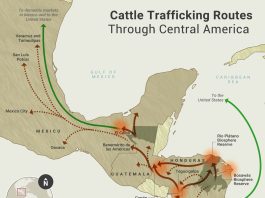
A few weeks ago we introduced Robert E. Williams and Part 1 of his article in the Journal of Range Management about best grazing management practices. Though “Modern Methods of Getting Uniform Use of Ranges” was written 68 years ago, the principles he includes still hold true today. In fact, much of what he writes could be considered “regenerative.” So, here is an “everything old is new again” look at grazing management, with some comparisons to what we do today. (And for those of you who don’t work on the range, just substitute the word “pasture” and it works for you too! :-))
Livestock Management Practices
Herding
Herding of livestock, either on a continual or period basis, is one of the best ways of getting uniform use on ranges. The old saying “the eye of the master fattens the cattle” might be adapted by range men to say “the eye of the rancher improves the range and fattens the livestock”. The successful stockman not only watches his cattle carefully, he also studies forage, soil and moisture conditions carefully and constantly to make necessary changes in management.
The grazing habits of livestock on the range may change from year to year because of rainfall differences, severity of frosts and other reasons. The range rider who has covered the same range for several years is in a position to recognize the reasons for the variations in grazing habits from the normal and can thus move stock as needed or make other necessary changes to get uniform use.
In parts of the South, cattle tend to graze creek and river bottoms in the winter months, browsing the hardwood sprouts and cool season grasses and sedges which grow on these sites. Use of these areas is particularly heavy in severe winters when the bluestem range of the cutover flats and rolling hills has little to offer in the way of green forage. During mild winters, considerable green forage is found in the bluestem range throughout the season, and cattle tend to graze these areas all winter resulting in better natural grazing distribution.
During dry years, marsh ranges in southern Louisiana and Texas are more uniformly grazed because water levels are lower and cattle can cover more ground. During wet years, range riding or herding prevents severe overuse of the higher areas.
The practice of sheep herding in the West, particularly in connection with the one-night bedding system, has resulted in better distribution of grazing and has contributed greatly to range improvement on many areas (Fleming, 1922 ; Pechanec, 1949).
Good initial distribution is important when livestock are placed on the range. If cattle are left in large groups in locations where forage, water and salt are available, the animals tend to remain in those areas until the supply of one or more of these necessities become deficient resulting in heavy use in some areas and little use in others (Fig. 2).

Sixty-eight years later….
While range riders fell out of favor for some time, it’s a practice that is once again encouraged. Bob Budd successfully used range riding to teach cattle to leave riparian areas, allowing them to heal and provide habitat for countless birds. Range riders are also being encouraged as a way of protecting livestock from predators. For those of us not working on the range we tend to use fencing and rotations to solve the problem of animals grazing too long in one place.
The key principle that has not changed is the importance of paying attention to forage, soils and livestock and moving livestock accordingly. It’s an old saw* that continues to be played over and over again. If you don’t monitor, or need some ideas of what and how to monitor, here’s the article for you:
https://onpasture.com/2017/10/23/how-do-you-monitor-your-pastures/
Salting and feeding
Some ranchers prefer to feed or salt livestock near water, corrals or other permanent locations on the range because of the convenience in checking livestock. Many other ranchers realize that it is more important to watch the grass as a means of looking out for the welfare of their stock.
Bentley (1941) showed that when salt was placed away from water on range in the ponderosa-Jeffrey pine type, cattle did not go to water directly after salting but grazed the outlying forage in the salting area.
Use of salt blocks is a practical method of salting to improve grazing distribution. The new blocks are placed in a different location as the old ones are used up. Blocks can be placed on rocks, stumps, or on stakes driven in the ground. Portable salt and mineral boxes are being used by many ranchers. When the troughs need refilling, they are moved to new areas where forage is abundant. Some troughs are made on skids to be moved by truck or tractor; other types may he loaded and hauled to the desired location.
The Southwestern Forest and Range Experiment Station (1952) reports considerable success in improving uniformity of range use with salt-meal mixtures. Supplement was fed at and away from water in one pasture and away from water, only, in a second. Treatments were reversed the second year for comparison. Improvement was made by reducing areas of excessive use and increasing the areas of proper use. Stoddart and Smith (1943) describe the use of salt on the lower ranges only to hold cattle at lower altitudes until higher ranges are ready to graze.
The practice of supplementing dry grass hay by feeding good legume hay in portable feed racks is gaining in popularity in the South. These racks are built on skids and can be moved about, periodically with tractor or truck. This practice has not only contributed to more uniform use of the range, but several ranchmen claim it results in lowering the amount of hay and other feed required to feed cattle satisfactorily.
A very common practice on many ranches is that of carrying hay, cake or cubes onto the range in a truck or pickup, blowing the horn to call the cattle, then feeding them on the spot or leading them to underused areas. The operator is able in this way to control grazing distribution and to check on his cattle with very little trouble. This practice can receive its widest application only on range of gentle topography, but it is very effective once the cattle become accustomed to it.
Sixty-eight years later….
But we have new supplement options and new research demonstrating how they can help us:
Work by Derrick Bailey reinforced the use of using some kind of supplement to move cattle away from water sources so they would more effectively graze uplands. But, instead of salt, Dr. Bailey used protein supplement tubs, something not available back in 1953. His research demonstrated that these tubs were more effective than salt at keeping livestock away from water sources. You can read more about his research and get tips for how to use this technique to keep your animals where you want them.
One last point: If you’re placing your salt or supplement next to your water source, stop! It was a bad practice 68 years ago, and it still is today. It encourages livestock to congregate in one place, hammering the soil and forage and depositing too much manure there instead of spreading it over pastures and the range. It’s bad for water, soil, forage and your bottom line.
Miscellaneous
Several other livestock management, practices help to improve grazing distribution. Shearing with portable outfits on sheep allotments instead of at commercial or association plants and trucking sheep to and from range units lessen use along driveways and reduce trailing. Better predator control makes it possible to bed out sheep wherever night, overtakes them. Cattle sprayed regularly with fly-repellent, sprays do not concentrate in brush or other protected areas.
Sixty-eight years later….
Predators and flies continue to be a problem. But we’ve learned a bit more about living with both. Here’s how one community has been working on solving predator problems locally:
And here’s a collection of articles on managing flies:
Garlic for Fly Control?
Fly Management to Reduce Pinkeye Problems
Stable Flies Can Be a Problem Even If You Don’t Have Stables
Farm Hack Fly Traps
Paint Cows Like Zebras to Reduce Flies
Coming up, we’ll look at what Mr. Williams has to say about forage improvement practices and grazing management back then and compare them to what we do today. Stay tuned!
*“Old Saw” – is an old standby phrase (to the point of being a cliche) but still rings true. I have no idea if it has anything to do with playing a saw, but since we’re all about “how-to” here at On Pasture, here’s an instructional video on how to play a saw. Enjoy! 🙂




